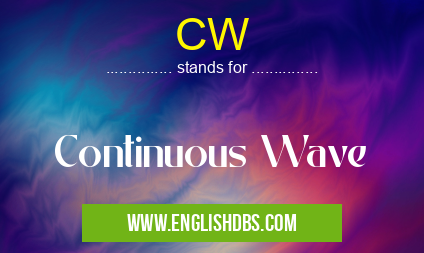What does CW mean in ELECTRONICS
CW stands for Continuous Wave, a type of signal transmission in communications technology. It is used to refer to any electromagnetic wave that is sent as an uninterrupted stream, rather than in a series of coded pulses. The continuous wave form allows for modulation and therefore communication over long distances using various carrier frequencies. This type of transmission can be used in different applications such as radio broadcasting, cellular networks, satellite systems and even for streaming audio or video content.

CW meaning in Electronics in Academic & Science
CW mostly used in an acronym Electronics in Category Academic & Science that means Continuous Wave
Shorthand: CW,
Full Form: Continuous Wave
For more information of "Continuous Wave", see the section below.
Definition
In physics, a continuous wave (CW) is an electromagnetic wave produced by the modulation of an alternating current at a specific frequency. Such waves propagate through space without being bound to any particular medium or reflection from the environment. They can be generated either naturally or artificially. Examples of natural sources include the emission from stars, planetary atmospheres, lightning and other electrical discharges. Artificial sources include electronic oscillators and naval navigation radars. CW signals are typically found in the form of sound waves, light waves or radio waves with very low bandwidths due to their simplicity.
Functionality
Continuous Wave transmissions are used in many communication systems because they can carry information over vast distances without interference. This makes them highly efficient since they don't require large amounts of energy to maintain signals over long distances like other forms of transmission do. Moreover, their inherently simple nature makes them immune to noise and distortion which can reduce the quality of data transmitted over other methods such as Frequency Modulation (FM) or Digital Multiplexing (DM). Furthermore, CW transmissions have historically been used for Morse code transmissions due to their simple nature and ability to travel long distances relatively efficiently at reduced power levels compared to other modes of data transfer.
Applications
CW transmissions are commonly used in many different fields and for many different purposes; some examples include television broadcasting, cell phone towers, Wi-Fi networks, radar systems and satellites communication networks among others. Notably, they are employed heavily throughout the aviation industry for navigation purposes where pilots use them to navigate during flights due to their dependability and consistency over long ranges compared to FM broadcasts which can be affected by atmospheric conditions or interference from objects in close proximity such as mountains or buildings. Additionally CW signals are also employed in medical imaging techniques such as Magnetic Resonance Imaging (MRI). For this application specifically they penetrate further into tissues than radiofrequency modulated acoustic waves do since bones absorb RF energy more easily.
Essential Questions and Answers on Continuous Wave in "SCIENCE»ELECTRONICS"
What is Continuous Wave?
Continuous Wave (CW) is a type of radio transmission that involves uninterrupted periods of carrier wave transmissions. It is used in the Morse code protocol which enables efficient transmission of data. It can also be used for voice communications, particularly in Ham Radio.
How is CW different from other forms of radio transmissions?
CW differs from other forms of radio transmission because it has uninterrupted periods of carrier wave transmissions. The Morse code protocol uses CW to efficiently send data. Additionally, CW can also be used for voice communication, something not possible with other forms.
What type of device is required to use CW?
A shortwave transceiver with an antenna and a keyer are necessary components when using CW. With the right equipment, any operator should be able to successfully transmit information using continuous wave technology.
Are there frequencies specifically dedicated for CW operations?
Yes! Often times you will find Amateur Radio operators on specific frequency bands dedicated for use with continuous wave operations such as 80 meters or 40 meters frequency bands.
What types of signals can I send with Continuous Wave?
Using this mode you can send Morse code, Radioteletype (RTTY), or voice signals. This depends on your hardware but most modern transceivers will allow for all three types of signal transmission via CW form.
Final Words:
Continuous Wave (CW) is a popular method for transmitting information across long distances with minimal interference because it doesn’t require much power while still providing reliable results when necessary. With its wide range of applications from broadcasting television shows and communicating via cell phones towers & mobile devices all the way up through sophisticated medical scanning equipment; it has become one of the most significant technologies employed in modern life today!
CW also stands for: |
|
| All stands for CW |
